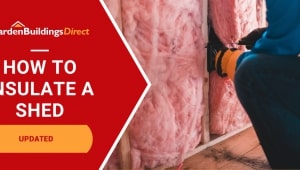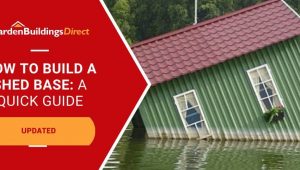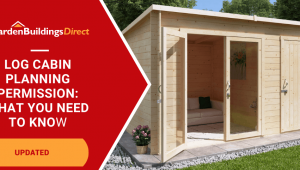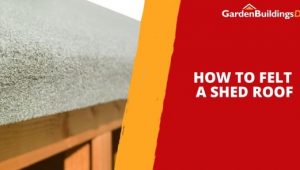Jump to:
Condensation in a summer house is a common problem, especially during the humid British summers. It can lead to unwanted issues such as mould, mildew, and even damage to the structure if not managed properly. Stopping condensation in your summer house is crucial for maintaining a comfortable, dry, and healthy environment. In this guide, we’ll explore the main causes of condensation in a summer house and provide practical tips on how to stop condensation in a summer house effectively.
Whether you already own one or you’re shopping for summer houses and have concerns, this guide is for you.
What Leads to Condensation in a Summer House?
Before you can solve the condensation problem, it’s essential to understand what causes it:
Temperature fluctuation
When there is a drastic difference between the inside and outside temperatures, moisture in the air condenses, often appearing as water droplets on windows and walls. During cold weather, this is particularly noticeable.
Humidity level from people and plants
Humans release moisture through breathing and perspiration. In a garden gym, for example, this can be quite pronounced. Plants can also contribute, though to a lesser extent, by releasing moisture into the air through transpiration.
Lack of ventilation
Without proper airflow, the moist air in the summer house becomes trapped, contributing to condensation. This is often compounded by high humidity levels, particularly if the room is used for activities like exercise or cooking.
Untreated timber
Wooden structures, especially with untreated timber, are prone to absorbing moisture. Without a protective treatment, the wood will retain moisture, worsening the condensation problem by trapping humidity inside. Not to mention the damage this can cause to the building itself.
How to Stop Condensation in Your Summer House?
Now that you know the main causes, let’s explore the most effective solutions to combat condensation.
Insulate your summer house
Insulation creates a barrier that helps maintain a stable indoor temperature, preventing the rapid temperature fluctuations that cause condensation. By reducing heat transfer between the inside and outside, the insulation keeps the internal surfaces warmer, which lowers the likelihood of condensation forming.
Types of Insulation:
Rigid Foam Boards: Excellent for thermal resistance, these can be used on floors and walls.
Mineral Wool: Provides good sound and thermal insulation.
PIR Insulation Boards: These are perfect for the roof, providing a more energy-efficient solution.
You can do this yourself or hire a professional for proper installation. Experts can also recommend the best type of insulation for your summer house. For advice on what the process consists of, read our detailed guide on How to Insulate a Summerhouse.
Note: If you have a log cabin summer house, insulation is still worth considering. While the thick logs offer some insulating qualities already, adding extra insulation can provide more comfort and reduce condensation.
Use a dehumidifier and choose your plants wisely
A dehumidifier actively removes excess moisture from the air, reducing the risk of condensation forming. It’s an essential tool for controlling humidity in a garden room.
Some plants, like the Peace Lily and Areca Palm, can absorb moisture from the air. However, their dehumidifying effects may not be substantial in larger rooms or spaces with excessive humidity. You may want to limit the number of plants in high-humidity areas to prevent further moisture build-up.
Improve airflow and ventilation inside your summer house
You can do this by installing vents or an exhaust fan so air can move around and keep the space cooler and drier. Even small changes like cracking open a window (if they open) or leaving the doors open periodically can help.
If you’re using the summer house for exercise or other activities that generate moisture, our guide to ‘How to Ventilate Your Garden Gym’ has more tips for you!
Treat your summer house timber
The right wood treatment can help keep the wood dry and reduce the risk of moisture build-up that could lead to condensation. It also prevents the wood from rotting, warping, or weakening over time.
Opt for deeply penetrating, water-repellent options like tung oil, linseed oil, or silicone cream emulsions. Emulsion creams, for instance, retain the wood’s natural appearance while ensuring it stays protected against moisture and the elements. Treat the building annually, or at least every couple of years, to maintain its condition.
Now, if it’s a pressure-treated summer house, it will likely require less frequent treatment. Yet, keep in mind that pressure-treated wood mainly helps with durability and resisting insects. You can still treat it with a water-repellent solution or use insulation to manage humidity.
As a rule of thumb, wait for a brand new pressure-treated structure to dry out after installation for 3-4 months or longer, up to 6 months, before applying treatment. If yours hasn’t been treated in years, you can go ahead with treatment as long as the surface is clean and free of debris.
Install a Damp Proof Membrane (DPM)
A Damp Proof Membrane (DPM) is a physical barrier that helps prevent moisture from rising through the floors of your summer house. This is especially important if you have a concrete base. Typically, a DPM is installed beneath the concrete slab during the initial construction to prevent rising damp from the ground.
How to Install a DPM After Construction:
If your summer house already has a concrete base, it can be more challenging to install a DPM, as it would traditionally go under the base during construction. However, you can apply a surface DPM by adding a layer of screed (a cement-based layer) with a membrane on top. This can help block moisture from rising through the concrete.
For wooden floors, you can lift the floorboards and install a DPM underneath them to prevent moisture from seeping up into the timber.
If moisture is coming through the walls or you suspect rising damp, you can install a DPM along the lower part of the walls to create an additional moisture barrier.
Additional Tip: If you’re dealing with persistent moisture issues, it’s advisable to pair the DPM with proper insulation and ventilation to create a more effective barrier against dampness.
Round-up
To combat condensation in your summer house, you’ll need a combination of strategies. Insulating the space, using a dehumidifier, ensuring proper ventilation, and treating the timber will go a long way. Additionally, installing a damp proof membrane can provide an extra layer of protection, especially in areas prone to moisture ingress.
You’ve got this now!
See our summer house guide for everything you need to know about these fabulous garden buildings.





